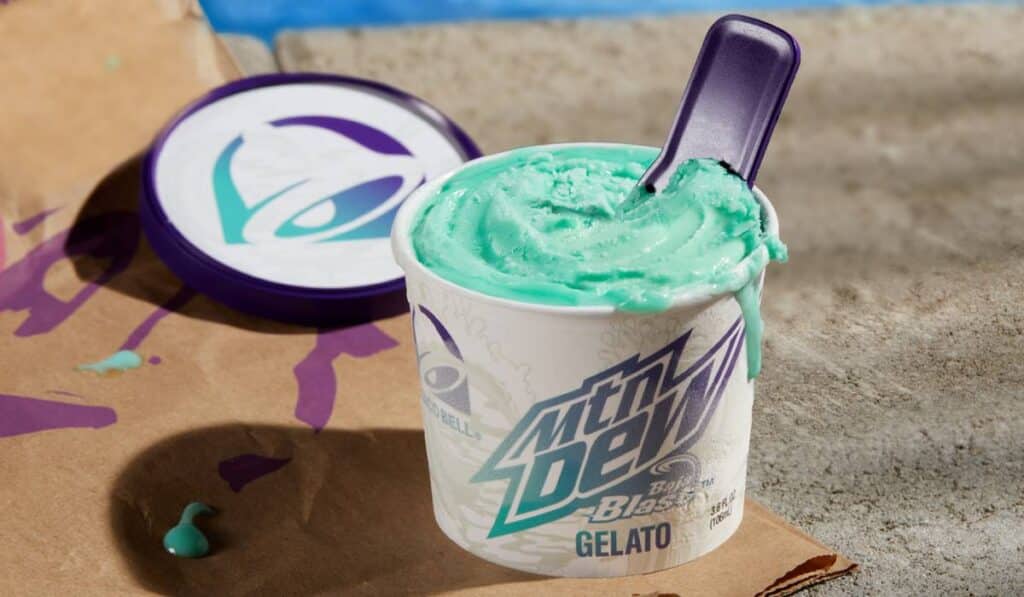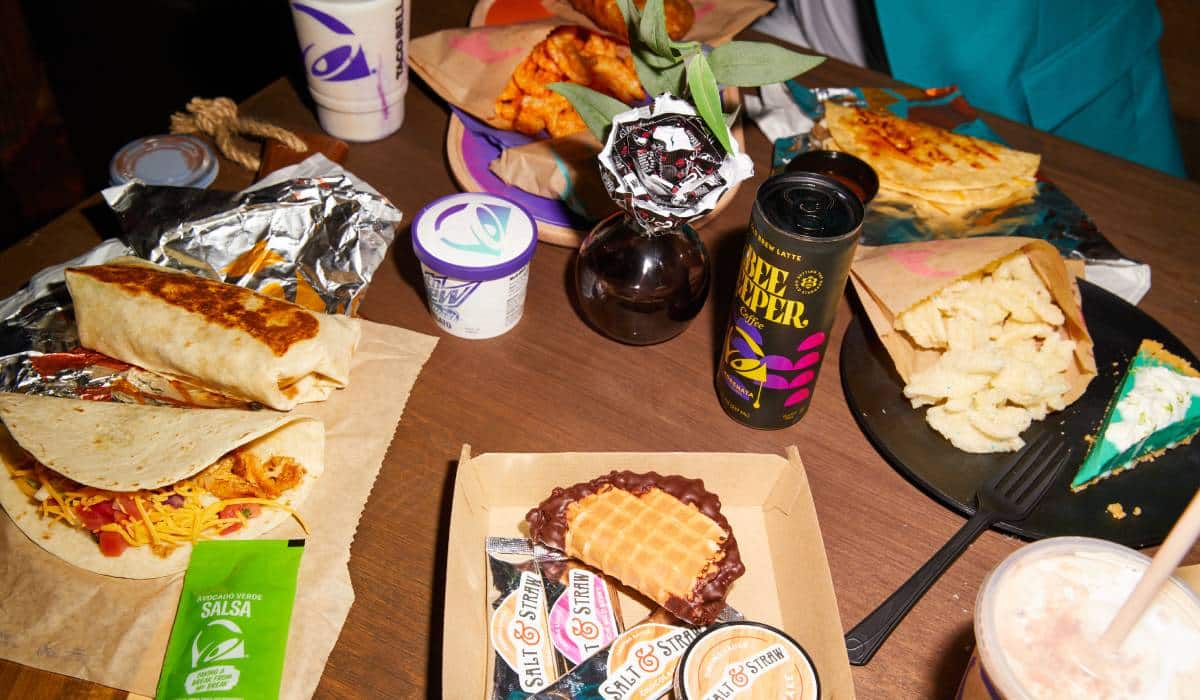When Taco Bell CMO Taylor Montgomery sums up the Mexican chainâs marketing muse, his mind focuses on two wordsâcultural rebel.
To be clear, when he uses that phrase, he isnât limiting that to Gen Z and millennials. It could be anybody, from country music sensation Dolly Parton to rising rapping artist Doja Cat. The chain attempts to learn from different cultures as much as it tries to influence them.
As Taco Bell repeatedly dives into the zeitgeist, it also understands the brand belongs to its fans. Itâs a major reason why the company decided to free the âTaco Tuesdayâ trademark last yearâpreviously owned by Taco Johnâsâand use LeBron James to market its efforts. Or why it hosted a wedding inside a Metaverse chapelâsomething that received more than 300 applicants.
Above all, Taco Bellâs marketing philosophy and responsibility to its customers shine clearest when it comes to menu innovation. The fast-food giant kicked off 2024 with a bang when it held its first Live Más Live event during Super Bowl week in Las Vegas, where it announced several new menu innovations in a style akin to Apple unveiling new tech products. The moment was a combination of two pointsâwanting fans at the forefront and a belief that Taco Bell is the most innovative brand in the world.
âSo what we wanted to create with Live Más Live was, what is a way that we can actually show those two thingsâto the culture and to our fans and the people that matter most,â Montgomery says. âI think the thing for us on Live Más Live that was most important and what the team and I thought about a lot is, you canât just talk about it. You got to be about it. You got to walk the walk, you canât just talk the talk. So thatâs where it came from, âHey, how do we create a moment that lets culture into those two things and helps us show and prove that we are those two things and weâre a brand thatâs all about the fans and weâre the most innovative brand?â
Among the announced creations were the Cheesy Chicken Crispanada, Crispy Chicken Nuggets, Cheesy Street Chalupas, MTN DEW Baja Blast Gelato, Cheesy Enchilada Dipping Taco, Dule de Leche Cinnabon Delights, and a Cheez-It Crunchwrap.
The Cheez-It Crunchwrap features a Cheez-It cracker 16 times the size of a normal one.
 The unique gelato product showcases Taco Bell’s differentiation in the quick-service space.
The unique gelato product showcases Taco Bell’s differentiation in the quick-service space.
Chief food innovation officer Liz Matthews says Taco Bellâs approach to innovation has changed since COVID hit the U.S., mainly due to the advent of the delivery business. With the additional revenue channel, there are more opportunities to do promotions with product drops and the loyalty program. Matthews adds that demand from customers has increased as well. Thereâs still pent-up excitement from the past few years, and guests are eager to treat themselves to foods theyâve never come across before.
Taco Bell is further engaging its loyal customers by introducing a new product every five weeksâdouble the frequency seen in 2023.
âWe want to have news on Taco Bell all the time,â Matthews says. âSo youâre going to be hearing buzz throughout the year, like every week. Whether itâs something that weâre doing with our loyalty program, whether itâs a new product launch, thatâs what people love about our brand. They want to see whatâs coming next.â
The love for Taco Bell is so great that sometimes the brand has issues with new food products getting leaked online. That was another benefit of the Live Más Live eventâif customers are chomping at the bit to uncover news anyway, why not get ahead of it and make a big show out of it?
âI think thereâs always speculation that people are guessing and trying to figure out what weâre doing, and I think we just took a different approach this year,â Matthews says. âWeâre like, you know what, we should just put it out there because itâs coming and weâre ready and weâre excited. So it was just more of a different approach to make sure they donât have to keep guessing anymore or speculate on Reddit.â
Taco Bell uses several techniques to gather information for its product innovations team so they know whatâs worth spending time on. The first tool is using industry data; basically, what are customers consuming, even at the competitionâs drive-thru and dining room? Social media plays a significant role as well. Taco Bell also completes a daily and monthly review of what guests are saying about its menu and what theyâre saying about its market tests. Workers go into the field and talk to employees about what consumers are telling them.
Montgomery looks at every opportunity as a focus group. Sometimes heâll attend his daughterâs dance practice and the other parents give him plenty of feedback about certain items. His primary job is to be an open ear and be more in tune with what the consumer wants than anyone else.
All of those aforementioned channels are how Taco Bell knows chicken is gaining massive popularity in the U.S. Innovation was adjusted accordingly. In March, the chain debuted a Cantina Chicken Menu, including the Cantina Chicken Burrito, Cantina Chicken Taco (soft or crispy), Cantina Chicken Quesadilla, and the Cantina Chicken Bowl. Within these meals, the chicken is oven-roasted, shredded, and combined with seasoning of Mexican spices like pasilla and other chilies. New ingredients include purple cabbage, pico de gallo, a white corn taco shell, and Avocado Verde Salsa.
âConsumption of chicken is just rising. whether itâs grilled chicken, fried chicken,â Matthews says. âAnd consumers are telling us that they want more chicken. They feel really good about eating chicken every single day and they want more options in that space. That really is what started it. And then we found this amazing slow-roasted chicken, put a lot of fresh ingredients around it, with amazing sauces with our new Avocado Verde. It all centers around that chicken, and honestly, it came from consumers just wanting more chicken options from us.â
Feedback loops are also a good way to determine what companies Taco Bell should partner with in terms of culinary innovation. Some recent examples are Cheez-It, TajÃn, Secret Aardvark, Disha Hot, Salt & Straw, and Beekeeper Coffee. The Cheez-It Crunchwrap, which has been on menus before on a limited-time basis, is ready for a nationwide rollout. It features a Cheez-It cracker 16 times the size of a normal one, with seasoned beef, nacho cheese sauce, and classic Crunchwrap fixings, wrapped inside a folded tortilla.
âObviously you could just find a lot of people to partner with,â Matthews says. âI think the most important thing is that we love what they do and they love what we do. So it starts with that. Itâs funny because someone was asking me, âOh, do you guys just start working on something?â No, we just start a relationship and we talk and feel out ideas together and just see if it makes a good partnership. But the most important thing is it has to be authentic. We love the guys weâre working with and they love our brand. That is the number one recipe for any kind of partnership.â
Taco Bell uses the massive love for food innovation to bolster its higher-margin, less labor-intensive digital channels. In some cases, the brand lets rewards members get their hands on menu items before anyone else. In other cases, the chain will hold a poll to let users decide which product they want to be available for a limited time.
The strategy works quite well. Taco Bell achieved a milestone in 2023 by surpassing $15 billion in system sales for the first time, with a significant portion of this revenue generated through digital channels. The brandâs digital sales mix reached an all-time high of 31 percent in Q4, marking a seven-point increase compared to the previous year. This growth is largely attributed to in-store kiosk sales, which saw a 15-point rise in Q4 compared to the same period last year. Moreover, Taco Bell has placed a strong emphasis on customer loyalty, evident in the 17 percent increase in its active user base in 2023.
The brand achieved a 24 percent margin last year while maintaining its position as a leader in key value perception metrics within the quick-service industry. Notably, restaurants located in low-income trade areas outperformed other segments of the business, both in the fourth quarter and throughout the entire year. Furthermore, the value menu, now adjusted to offer items priced at $3 and below, is proving to be popular among consumers compared to its testing phase.
Taco Bellâs goal is to âhave something for everyone,â Matthews says, and give people more reasons to visit frequently. Itâs a push against the much-maligned veto vote that all restaurants hope to avoid when reaching out to consumers. However, the brand acknowledges that it canât overdo innovation to the point that it becomes too much for employees in the back of house. Matthews notes that Taco Bell works to balance the introduction of products with making team membersâ lives as easy as possible. So when the company goes after a product, there have to be âbig swingsâ that consumers and workers are both looking forward to.
The funnest part of Matthews and Montgomeryâs jobs is that no days are the same. As for the mission of being a cultural rebel, that doesnât change.
âWe are much better at creating when we work on something for X amount of time and then move to something next,â Matthews says. âWe always have chefs in the kitchen. Weâre always talking to consumers. We definitely focus on multiple things every single day. We donât have a day on Twists or something like that. Itâs a lot of everything every single day.â





